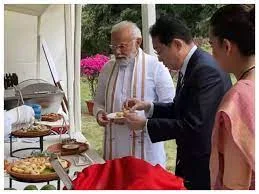The history of chaat can be traced back to the Mughal era when it was initially served as a snack to the royals. However, it became popular among the masses during the British colonial period when street vendors started selling it to the locals. Since then, chaat has evolved and diversified into various types and flavours, becoming a significant part of Indian street food.
There are various types of chaat, including Aloo Tikki, Samosa Chaat, Dahi Bhalla, Pani Puri, Bhel Puri, and many others. Each type of chaat has a unique taste and texture and is typically made with a combination of crunchy, spicy, tangy, and sweet flavours.
Chaat has gained immense popularity not just in India, but also across the world. With the rise of global cuisine and fusion food, chaat has also been reinvented and presented in different forms, such as chaat tacos, chaat pizza, and chaat salads.
Chaat culture has also been an inspiration for many chefs and food entrepreneurs, leading to the emergence of various chaat-themed restaurants and cafes in India and abroad. The popularity of chaat can also be attributed to its affordability, accessibility, and versatility.
Overall, chaat culture is an essential part of Indian food culture and street food, showcasing the country's rich and diverse culinary heritage. Whether enjoyed as a quick snack on the go or as a main course at a restaurant, chaat continues to capture the taste buds of food lovers worldwide.
Regional Variations:
While chaat is popular all over India, it has different variations depending on the region. For instance, in Mumbai, you can find the famous Pav Bhaji and Vada Pav, while in Kolkata, you can enjoy the spicy Jhal Muri. Delhi is known for its Aloo Tikki and Chole Bhature, and in Ahmedabad, you can savour the tangy and spicy Pani Puri.
Health Benefits:
While chaat is considered a street food and may not seem healthy at first glance, it actually has several health benefits. Chaat typically includes ingredients like chickpeas, potatoes, and yoghurt, which are rich in protein and fibre. Additionally, the spices used in chaat can help improve digestion, reduce inflammation, and boost metabolism.
Serving Styles:
Chaat is typically served in small portions, making it an ideal snack to share with friends or family. It can be enjoyed as a quick bite on the go or as a starter dish before a main meal. In some cases, chaat can also be served as a complete meal, especially when it includes ingredients like boiled chickpeas or potatoes.
Social Significance:
Apart from its taste, chaat has a social significance in Indian culture. In many parts of India, enjoying chaat with friends and family is seen as a social activity that brings people together. Street food stalls selling chaat are also popular gathering spots where people from different backgrounds and communities come together to enjoy their favourite snacks.
Innovation and Creativity:
Chaat culture has also inspired many chefs and food entrepreneurs to create new and innovative dishes using traditional chaat ingredients. For example, restaurants may serve chaat in different forms like wraps, bowls, or sandwiches. Some chefs also experiment with fusion cuisines, creating unique dishes by combining chaat flavours with other global cuisines.
Festivals and Celebrations:
Chaat is also an important part of many Indian festivals and celebrations. During the festival of Navratri, people in the western states of India celebrate with a special chaat dish called Farali Pattice, which is made using boiled potatoes and spices. In North India, chaat is a popular snack during the festival of Holi, and in South India, chaat is enjoyed during the festival of Diwali.
Global Popularity:
Chaat has gained immense popularity globally and is now enjoyed by people all over the world. Indian ex-pats have introduced chaat to different parts of the world, leading to the emergence of chaat stalls and restaurants in many countries. Today, you can find chaat stalls in cities like New York, London, and Melbourne, serving traditional and innovative chaat dishes to locals and tourists.
Chaat culture is a significant part of Indian street food and cuisine, showcasing the country's rich and diverse culinary heritage. Its popularity continues to grow both in India and abroad, inspiring creativity and innovation in the culinary world. Chaat's unique flavours and ingredients make it a must-try for anyone looking to explore the vibrant and delicious world of Indian street food. Who can forget the picture of Indian and Japanese prime ministers relishing panipuri in Ahmedabad?
In conclusion, chaat is a diverse and delicious street food that has become an integral part of Indian cuisine. Its popularity continues to grow, both in India and abroad, and its unique flavours and ingredients make it a must-try for any food lover.This post is part of #BlogchatterA2Zchallenge.


Comments
Post a Comment